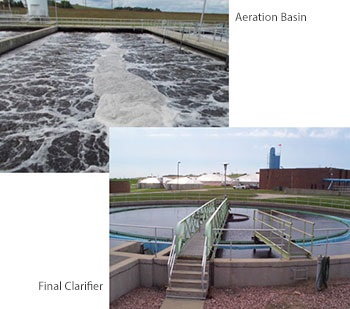The activated sludge system is designed to convert the ammonia into nitrates. After the wastewater leaves the two stage trickling filter system and the intermediate clarifiers any remaining organic material and ammonia left in the wastewater must be stabilized even further, and ammonia must be converted into nitrite.
The ammonia must be removed from the wastewater for two reasons:
- Ammonia is toxic to aquatic life in the Big Sioux River. The ammonia creates a huge oxygen demand in the River, for every pound of ammonia discharged into the Big Sioux River, requires 4.6 pounds of oxygen to stabilize into nitrate nitrogen. This would consume a lot of oxygen in the River that is needed by the fish and other aquatic life found swimming in the river.
- The Surface Water Discharge Permit issued by the State of South Dakota Department of Environment and Natural Resources, limits the amount of ammonia that can be discharged into the Big Sioux River.
The ammonia is converted to nitrates using a two-step biological process:
- The first step biologically converts the ammonia into nitrite, using Nitrosomonas bacteria,
- The second step bacterium converts the nitrite into nitrate, using Nitrobactor bacteria.
Once the ammonia is converted into the nitrate form, it is no longer toxic to aquatic wild life living in the Big Sioux River.
The organic material that is left over from the trickling filters that still needs to be removed is accomplished by using other bacteria that are populating the activated sludge system.
All of these bacteria require a lot of oxygen to accomplish these tasks of wastewater treatment. The water reclamation facility has four large mechanical blowers that can produce up to 15,520 cubic feet of air per minute, to supply all of the oxygen these bacteria need for the nitrification process and removal of the remaining organic material. On a typical day, only one blower is used to supply an adequate amount of oxygen to the activated sludge bacteria and occasionally a second blower is put in service if the organic loading on the plant increases for a sustained period of time.

The water reclamation facility has 6 aeration basins and each basin can hold up to 1,361,225 million gallons each and normally only 3 aeration basins are in service. The aeration basins house the activated sludge bacteria and are where all of the nitrification work and organic material removal is done.
There are also 4 final clarifiers that allow the activated sludge to settle out of the water, before the water proceeds to the effluent filters. Each final clarifier can hold 822,500 gallons of water.